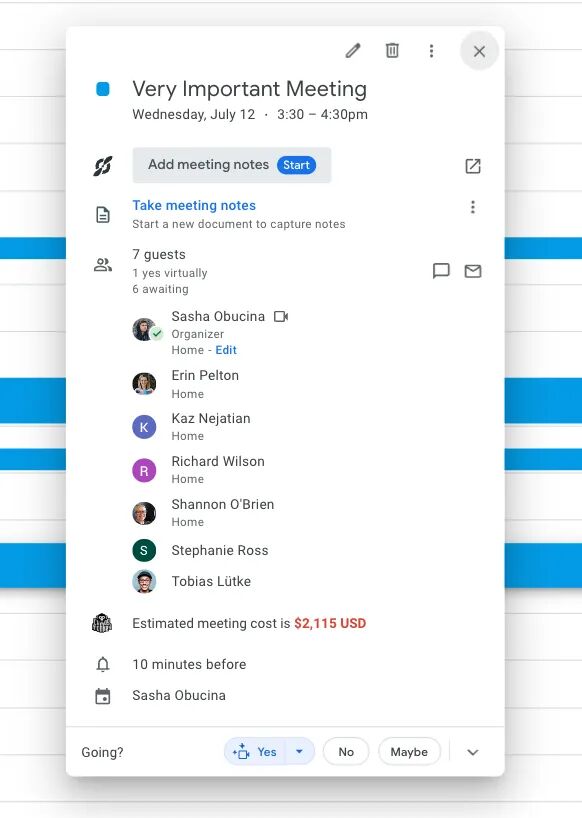A recent LinkedIn post included a screenshot of a Google calendar invitation for a “Very Important Meeting” at Shopify. Under the attendee list was the estimated cost of the meeting expenses, $2,115. The estimate was based on the pay rate of an hour of each person’s time. One challenge of our confirmation bias is that we look at what we want to be true, even if it is false. The person who posted the image doesn’t like meetings, suggesting that people should use their time to do other things.

This post was a case of knowing the cost of something without recognizing its meeting value. This is like weighing a raindrop and ignoring the storm.
I am aware that many companies have many meetings where nothing important gets done. But I am also aware of how effective meetings are when done right. So let us look at the other side of the ledger.
The Value of a Meeting
About $2,115 for a meeting is a significant amount of money, even though the company would have been paying for the time whether the employees were in the meeting or doing something else. The exercise here is to recognize that the attendees must do something valuable enough to cover the meeting expenses. It’s worthwhile to measure the value a person created alongside what they were paid and what they did during that meeting hour or because of it.
The likely reason Shopify made this investment in a “very important meeting” is because they needed to bring this group together to pursue some strategic outcome. My guess is that this meeting had to do with one of the following reasons:
- A big idea: If I guessed why they met, my first guess is that they were pursuing a big idea or important initiative. In this case, $2,115 for an hour in the meeting is almost certain to generate many times more than the cost of the attendees’ time. For example, if the CEO is an attendee, you know this meeting is significant.
- Alignment: One reason to have a meeting is to generate alignment within a team or across various departments. To reach alignment, getting people into a room for a discussion is far more effective than an email. Email and other async communications are not nearly as helpful as asking questions, having a discussion, and leaving the meeting with everyone in alignment and ready to execute.
- Accountability: Based on what little we know, it isn’t a stretch to believe the attendees are leaving this meeting with marching orders for which they will be accountable. When you leave an effective meeting, everyone should know what they need to do and the timeline for completing it.
- Execution: A new initiative will require execution. Important meetings will inform each person what and how they need to execute their part. In this type of meeting, the attendees have work to do immediately after meeting.
- Revenue: Shopify is a well-run company. Whatever the content of the meeting, it’s almost certain to generate $2,115. Whatever the content of the meeting, its impact is like a small spark that can ignite a forest fire, potentially generating hundreds or thousands of times more than the original $2,115 personnel cost.
The Cost of NOT Meeting
There is a cost to not meeting. Emails and async solutions like Slack can convey information to the people who need it. However, async is inferior to face-to-face conversations. There is no reason to adopt the processes of technology companies if you aren’t one. Async is great if your developers are in Nepal and you live and work in San Francisco, as you are in time zones that make this necessary.
The cost of not meeting is almost certain to exceed the cost of the meeting when it is around something important. Without a meeting, you may reduce attendees’ understanding of their role to a list of exact tasks that they need to do, without any key context or strategic understanding. Even though you can send an email or Slack message, it pales when compared to asking questions and clarifying anything that might be unclear. The best way to ensure everyone understands how they are working together toward the same goals is to get them in the same room.
Everything seems to take more time and more communication when it is async. The email you receive generates a long thread of responses that are next to impossible to follow. No one needs more time scrolling. Async platforms are overrun with so many threads that any time saved is lost to the time trying to find and follow the thread. A phone call is faster and more effective, and provides richer communication.
The Price of a Meeting
The price of a meeting needs to balance against the outcome of the idea and the potential improvement. Looking at only one side of the equation may look like it is expensive until you measure the outcome.
Some meetings, especially very important meetings, are worth many times the expense of the meeting, like the sales kick-off meeting that allows the senior leaders to communicate their future initiatives to their entire sales force at one time. It could have been an email, but the experience and the expense is an investment in their sales force and their future results.
You may incur a greater cost from not having the meeting about a big idea, alignment with your teams, providing accountability for their responsibilities, and the plan to execute.









.jpg?width=768&height=994&name=maximize-productivity-ebook-v3-1-cover%20(2).jpg)


